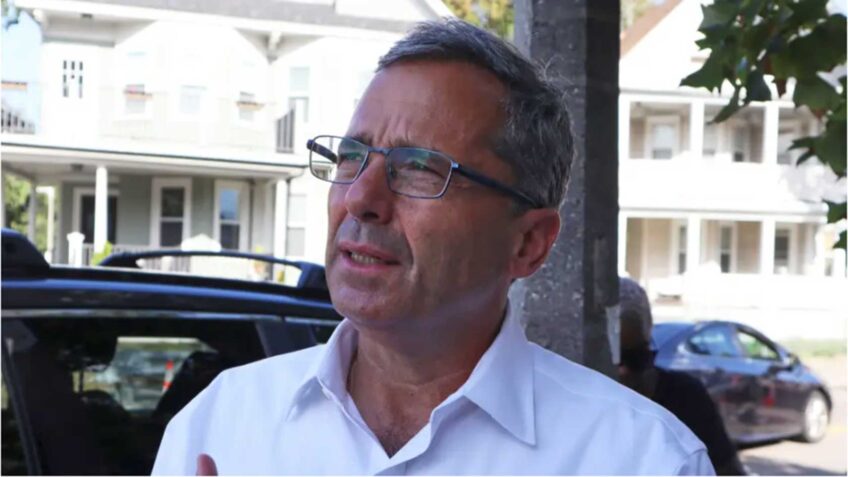EPA announces contamination removal options for Neponset River Superfund site

The U.S. Environmental Protection Agency released its proposals, this month, for how to deal with contamination in the Lower Neponset River Superfund site.
In an almost 450-page document called an Engineering Evaluation and Cost Analysis or EE/CA, the EPA outlined potential paths forward for removing the pollutants from the riverbed that led to its designation as a Superfund site in the first place.
That document, released June 13, included three plans to address contamination in the river plus a fourth “no action” option that is officially required.
The stretch of the river from Mother Brook, in Hyde Park, to the Baker Dam in Lower Mills was designated a Superfund site in 2022. A long history of industrial work in the area, including using the river’s flow to power factories, left the sediment in the riverbed contaminated with polychlorinated biphenyls, or PCBs, man-made chemicals that were a part of industrial production for decades from the late 1920s until 1979 when they were banned by U.S. law.
Exposure to PCBs, which bind to sediments in the river, can lead to a host of health concerns, including an increased risk of developing cancer.
The EPA previously completed advanced efforts along the river’s shore at the Hyde Park Lewis Chemical Site in October and is currently working to remove contaminated soil from Hyde Park’s Riverside Square.
Four options for river cleanup
The four options range in the extent of what they plan to tackle — and by extension cost — from the “no action” removal action alternative, included as a baseline for comparison, all the way up to a $78.4 million cleanup that would remove much of the PCB contamination and greatly limit the need for future action at the site.
The most limited removal action would address hotspots in the river, tackling only spots with a high threshold for PCB contamination. Remaining contaminated sediment would be temporarily “capped,” a process which involves leaving it in place and covering it with clean material.
Under that action, crews would also work to remove contaminated sediment upstream from the Tileston and Hollingsworth Dam. The report identified the dam as a potential risk spot, which, if it fails, could result in a “catastrophic and uncontrolled release” of contaminated sediment.
Ian Cooke, executive director of the Neponset River Watershed Association, said the dam, which was built in the 1960s, is “actually beyond the end of its useful life.”
At an estimated $29.9 million price tag, it would remove an estimated 34,400 tons of contaminated sediment and soil from the site over a planned timeline of two years and nine months.
The intermediate removal action would set a lower threshold for PCB contamination, meaning an estimated additional 12,000 tons of soil would be removed from the site. It also includes removal of the Tileston and Hollingsworth Dam.
The EE/CA estimates that the price would be over $11 million more expensive but would only take an additional month.
Under the most comprehensive removal action, the threshold for PCB contamination in the sediment would be much lower — 100 times less than under the first solution — meaning much of the riverbed would be dredged and cleaned, removing the top three feet of sediment through the full reach of the first phase of the project (from Mother Brook through the Tileston and Hollingsworth Dam, the remainder of the river will be addressed later).
It also will include removal of the dam and adding a permanent cap over the reach of the first phase.
The action alternative would remove an estimated 84,000 tons of sediment and soil.
Exactly how that work would be done isn’t outlined in the EE/CA, but Cooke said there are examples of how it might take place.
A previous clean up on Mother Brook, a smaller waterway that’s part of the Neponset watershed, involved the construction of temporary dams along the river and pumped the brook around the dry stream bed to excavate — a process that could prove unwieldy with the greater flow of water in the main stem of the river.
A separate project in Walpole involved building a wall down the middle of the river to divert the water to one side or the other, leaving half the riverbed dry at a time to work.
Or, the project could be tackled by dredging via a barge, he said.
The comprehensive solution clocks in at the most expensive, estimated to cost $78.4 million, over twice that of the most limited removal action. But spending the additional money up front might save costs later.
Both previous two removal actions would likely require additional dredging and work later, unlike the most comprehensive solution. In its EE/CA, the EPA said that it found the comprehensive solution “likely to be the most cost-effective alternative.”
Working in a river like this, Cooke said, makes for a “huge amount of work to do,” including just bringing in and setting up the equipment needed. That lift, Cooke said, makes him think that any of the lesser options that would not leave the river acceptably clean for the long term, would be more costly.
“I strongly suspect — and I’m not a construction expert — that doing half a job and then coming back to do the other half of a job later — particularly in this riverine environment — would be more expensive than just doing it all at once,” Cooke said.
In its EE/CA the EPA recommended comprehensive cleanup as its preferred removal action for the site.
Local support for comprehensive action
Cooke said that, as he understands it, the typical way to do a removal action isn’t to do the kind of comprehensive clean up that would really get down to a finished level of remediation in the first go.
But tackling it all at once makes more sense in a river environment, he said, where the flow of water creates more variable conditions and a stronger incentive to go in and get it fully cleaned up.
“I think in the case of a river, that really changes some of the incentives and the concerns,” Cooke said. “It’s not like this material is necessarily stabile at the bottom of the river. The next big hurricane that we happen to have could send it downstream and potentially make it a lot more expensive to clean up.”

Members of the Lower Neponset River Superfund Community Advisory Group at the group’s monthly meeting at the Hyde Park Community Center, June 17. The EPA, this month, released a document outlining four potential options they could pursue to remove contaminated sediment from the river. PHOTO: AVERY BLEICHFELD
That kind of solution would also be a good outcome from the community’s point of view, he said.
He said he thought it was “pretty clear” that the comprehensive clean-up option was best.
Ken Fields, a Hyde Park resident, spoke positively of the comprehensive option, but said the Community Advisory Group, a collection of local volunteers intended to represent local stakeholders and provide input to the EPA, hadn’t officially decided to voice its support for the comprehensive option.
The level of contamination that would be left following the removal option would be at a “very acceptable level,” he said, but the group was looking for more information about the permanent caps that would be added, to make sure they seem satisfactory given the kind of variable river environment that Cooke, too, pointed to.
“If you just look at the Colorado River and you look at the Grand Canyon, you understand that water has incredibly strong erosional effects on sediments and even on rock,” said Fields, a member of the CAG. “When you put a cap on top of remaining sediments, is that erosional factor going to disturb the engineering of the cap that is sequestering those remaining materials from future exposure?”
The group, he said, was also on the lookout for other details they want before they officially commit.
“As we get deeper in this document, we have to see what else it is we don’t know,” Fields said.
Removal of the dam is a tantalizing concept for Cooke and others from the Neponset River Watershed Association. Cooke said much of the work that led to the designation of the Lower Neponset as a Superfund site stemmed from efforts to get the dam removed.
When it was first proposed, the concept of removing the dam was a largely ecological one that would allow diadromous fish — those that migrate between saltwater and freshwater, like the herring, shad and alewife that used to traverse the Neponset — to return up-river.
Efforts to study what the removal of the Tileston and Hollingsworth Dam, along with the Baker Dam in Lower Mills, would mean for the river led to the discovery of the PCBs and, ultimately, the area’s designation as a Superfund site.
“We’ve certainly been supportive of removing the dams as a way to restore fish passage for a long time,” Cooke said. “I think it makes a lot of sense to combine the dam removal action with the sediment cleanup because managing sediments is always a big part of any dam removal.”
Next steps for the Superfund process
The release of the EE/CA started the clock on a 30-day public comment period. Community members can submit comments online or at a public hearing next month.
The EPA is also working to release a fact sheet about the EE/CA that breaks down what’s included, as well as a recorded video presentation explaining the options to help community members submit informed comments.
The Community Advisory Group may seek to extend that period with either a 15- or 30-day extension.
At a June 17 meeting of the group, members suggested that an extension could allow for better outreach to the community. They discussed organizing an event where community members could come, ask questions, review the EE/CA and submit public comments on provided computers.
Karen Grace-Horan, community engagement strategist and a member of the CAG, said she thought the group owed it to the community to seek an extension and try to provide their own outreach.
Bill Lovely, emergency response and removal section chief for the EPA, said the Lower Neponset “wouldn’t be the first site” to receive that kind of extension, though he declined, at that CAG meeting, to “predetermine” if an extension would be approved.
Part of the calculus around an extension is what could be a tight timeline to seek funding for the work. Money for the removal action could come from two separate sources and Lovely said the team is currently pursuing a “dual track,” in trying to identify how the work will be funded.
The EPA is asking potentially responsible parties — people, businesses, government entities or others who might have some responsibility for contamination at the site — to fund the removal effort. But if those efforts don’t pan out it will pursue funding through a pot of federal money set aside for remediation of sites like the Lower Neponset River.
The program, officially called the Comprehensive Environmental Response, Compensation, and Liability Act, is generally referred to as “Superfund” as it gets its name from an actual “superfund,” a trust fund that was established by the law that created the program.
Cooke said he had heard of a November deadline, based on an annual meeting, at which time representatives from the EPA would meet to discuss how to divvy up funding to projects nationwide. The comment period — as well as the official response process from the EPA, which will produce a Responsiveness Summary, responding to all community feedback, and an Action Memo with the final determination of the course forward — would need to be done by that time for the Lower Neponset project to be eligible for funding. The length of time it takes to put together the official response is based on what and how many comments the EPA receives on the EE/CA.
Waiting a year for the next meeting, Cooke said, could put that funding at risk with the shifting landscape of federal funds from the administration of President Donald Trump.
A spokesperson for the EPA said no official meeting has been scheduled. The spokesperson said that while funding cycles are important to progress at the site, actions are driven “first and foremost” to a commitment to protecting human health and the environment.
But at the CAG meeting, while he didn’t tie the process to a specific timeline, Lovely said that getting in a funding request sooner is likely better.
“Obviously, funding decisions are always uncertain, but I think our thinking is that the sooner we request the funding — meaning by the end of this year — the more likelihood there is,” Lovely said. “The further out we push the funding decisions, the less likely there is for certainty on that funding.”






